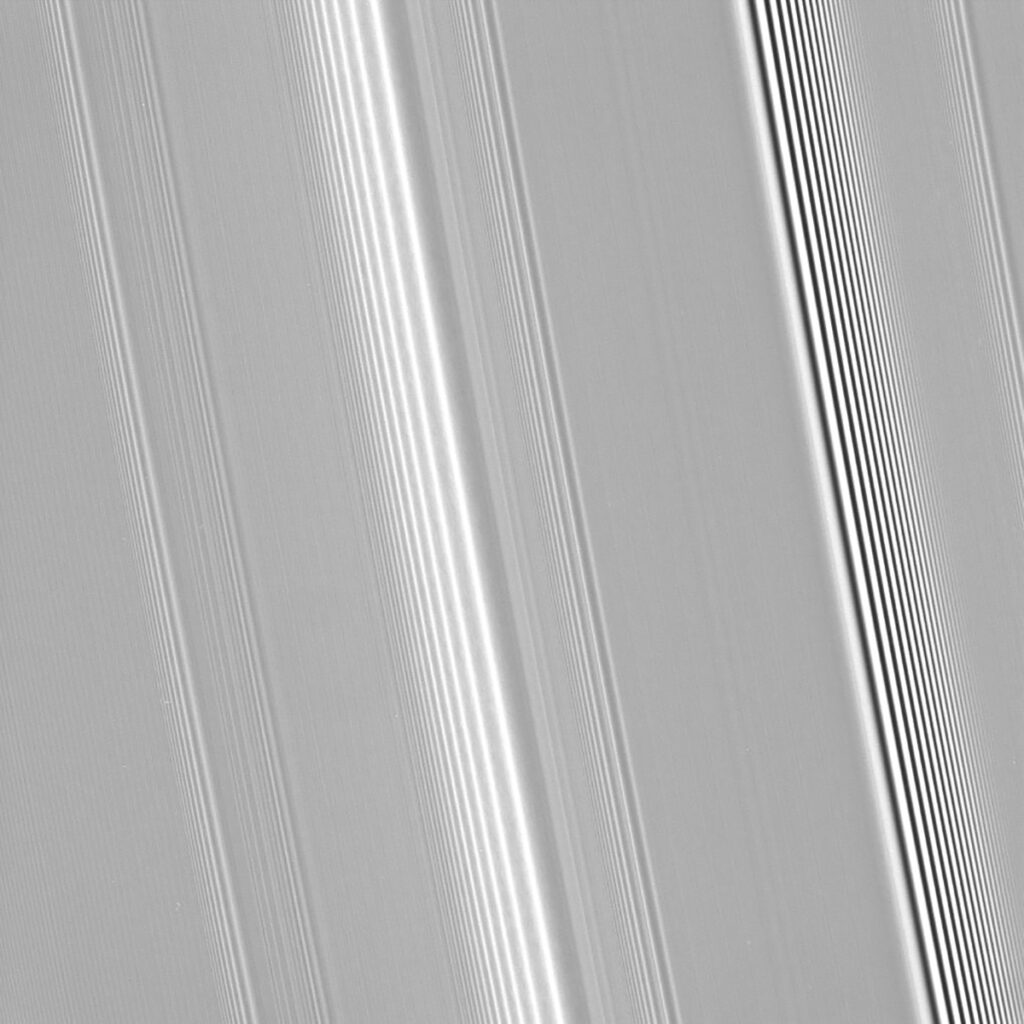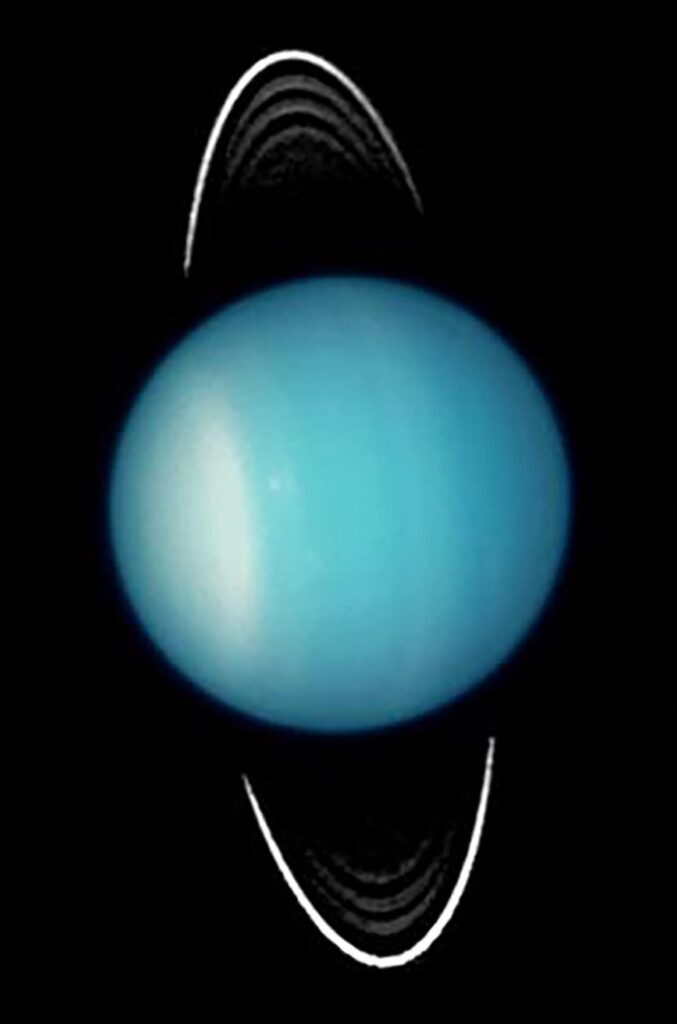The ice giant planets of our solar system, Uranus and Neptune, are far more mysterious than either Jupiter or Saturn and hold a great potential for new science. What little is known about them comes from the Voyager 2 flybys in the 1980s and the limited observations that can be done by ground-based telescopes. Almost nothing is known about what goes on beneath the planets’ clouds: the chemistry that hides deep within, the size of the core, the separation of atmospheric layers, or how far down convection extends. Ring seismology, a technique that was successful at piercing Saturn’s depths, might also help in understanding its smaller siblings.
“We’re studying the equivalent of earthquakes in giant planets.”
“We’re studying the equivalent of earthquakes in giant planets,” said Joseph A’Hearn, a graduate student in physics at the University of Idaho in Moscow. Attempting ring seismology of Uranus and Neptune is challenging because “we know much less about ice giant interiors than we do about gas giant interiors. That also works as an advantage for us because even if we only detect a few wave features in the rings, that already will tell us more about the interior than we knew before.”
Lessons from Saturn
Gravity is responsible for corralling shards of ice and rock into planetary rings and shaping them to its whims. Consequently, changes in the nearby gravitational field may be felt by the rings and disturb them enough to be visible to eyes or cameras. Different types of gravity perturbations—a large planet passing by, a moon on a resonant orbit, or convection deep within the planet itself—may cause the rings to stretch, warp, twist, or ripple. Ring seismology is the science of using those ring patterns to reverse engineer the cause of the gravity disturbance.

Understandably, the mind jumps to Saturn when thinking about planetary rings, and ring seismology has been used there to great effect. The Cassini-Huygens mission to Saturn caught many instances of waves in the planet’s rings, one type caused by passing moons and another caused by material shifting around inside the planet. “For Saturn,” A’Hearn said, “ring seismology was able to help us find a stably stratified layer in its interior; it was able to find that Saturn’s core is diffuse; and it was also able to constrain Saturn’s rotation rate. We’re hoping to learn similar things about Uranus and Neptune.”
Using a variety of different interior models for Uranus, A’Hearn and his team calculated where within the 13 known rings of Uranus we might expect to see perturbations caused by interior dynamics. Their calculations suggested that the narrow inner rings of Uranus are the right width, the right thickness, and at the right distance from the planet to catch at least one or two resonances predicted by the most plausible interior structures. A’Hearn will present these results on Friday, 17 December, at AGU’s Fall Meeting 2021.
“There is clearly a great potential in ring seismology for Uranus and Neptune,” said Ravit Helled, a planetary astrophysicist at the Center for Theoretical Astrophysics and Cosmology, University of Zurich, who was not involved with this research. “The interiors of Uranus and Neptune are poorly constrained, and using ring seismology could be used to detect interior oscillations and may identify the locations of regions in the deep interior that are convective and ones where convection is inhibited.”
What About Neptune?

A’Hearn’s group has completed calculations for only Uranus so far; results for Neptune are still in progress. The prospect of using ring seismology on the smaller ice giant planet is more uncertain. “Neptune has thinner and slightly farther out rings [than Uranus], perhaps beyond the region of resonance locations from waves originating in a stably stratified Neptune,” explained Nadine Nettelmann, a planetary astrophysicist at the German Aerospace Center’s Institute of Planetary Research in Berlin who was not involved with this work. However, “Neptune has about a 10 times higher heat flux, which may be indicative of stronger convective motions. Its atmosphere is also richer in cloudy structures than that of Uranus. Since convection is considered one of the main drivers for oscillations, those may be stronger in amplitude and thus easier to detect on Neptune than on the more quiet Uranus.”
“The convincing detection in the Uranian rings of even a single internal oscillation by the planet would be a significant advance and is well worth a concerted search,” added Richard French, an astronomer at Wellesley College in Wellesley, Mass., who was not involved with this work. “Neptune is more challenging still, in large part because we have very limited observations of its few narrow rings.”
“It’s more likely that we would need an orbiter to find these wave features.”
When combined with what we know about the structure and dynamics inside Saturn, ring seismology of either or both ice giant planets could provide better understanding of gas giant planet interiors, including for giant planets outside the solar system. “The internal density, pressure, and temperature are key characteristics of planetary interiors that can provide valuable clues about their formation environment and internal structure,” French said. “Placing Uranus and Neptune in context with Jupiter and Saturn will not only help us understand possible formation history of the solar system’s ice giants but will also give insights into many exoplanets of comparable size and mass.”
Is it possible to conduct ring seismology on Uranus or Neptune without an extended mission to the planets? Maybe, but not likely, said A’Hearn. “People have been looking in the Voyager data for these signals, but because Voyager was just a flyby, it probably didn’t collect enough…for us to determine these structures. People have also been looking with ground-based telescope data. And so it’s possible that we might be able to find a signal with those, but it’s more likely that we would need an orbiter to find these wave features.”
—Kimberly M. S. Cartier (@AstroKimCartier), Staff Writer


